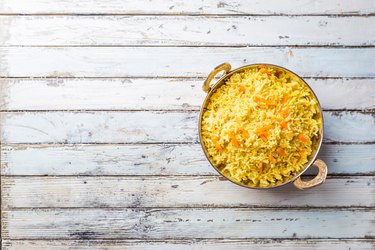
Rice is an important staple for billions of people worldwide. It is a good source of complex carbohydrates and other nutrients compared to maize, wheat and potatoes. Yellow rice is white rice with spices, such as saffron or turmeric, used to give it the yellow color. While recipes vary, coconut milk and onions are often added to the yellow rice in addition to the spices. In many cultures, especially Indonesian, yellow rice is an icon for traditional cuisine. It is the custom to serve healthy yellow rice, called Tumpeng, to celebrate significant traditional ceremonies.
Good Source of Carbs
Video of the Day
Rice is about 90 percent carbohydrate. One cup of cooked yellow rice contains roughly 45 grams of carbohydrates, and anywhere from 200 to 300 calories. Carbohydrates are an essential nutrient and your body's preferred source of energy. The U.S. Department of Agriculture says that 45 to 65 percent of your calories should come from carbohydrates. On a 2,000-calorie diet, that means you need 225 to 325 grams of carbs a day.
Video of the Day
Nutritional Benefits of Yellow Rice
Yellow rice is about 8 percent protein and 2 percent fat, primarily from omega-6 fatty acids which is considered pro-inflammatory. Although it does not contain beta-carotene, vitamin A, vitamin C, or lutein+zeazanthin, and is notably low in fiber, according to Ricepedia, yellow rice has some healthy benefits. It is a good source of minerals including calcium, iron, magnesium, phosphorus, potassium, sodium and zinc. Vitamins in yellow rice include thiamine, riboflavin, niacin, vitamin B-6 and folate.
If you use enriched white rice in your recipe, you will get added nutritional benefits from yellow rice. One cup of cooked enriched white rice contains 153 micrograms of folate and 1.9 milligrams of iron. Both folate and iron are nutrients of concern for women of childbearing age, according to the 2010 Dietary Guidelines for Americans. Adequate iron intake is important for red blood cell production and folate helps prevent birth defects. Teenage girls and women of childbearing age need 400 micrograms of folate a day, and 15 to 18 milligrams of iron.
Reduce the Sodium Content
Whether from a spice mix, broth or added salt, some versions of yellow rice may be high in sodium, with as much as 750 milligrams in a 1-cup cooked serving. High intakes of sodium are associated with high blood pressure, which increases your risk of heart disease. To keep a lid on your blood pressure, limit your daily sodium intake to no more than 2,300 milligrams a day. If you already have high blood pressure, are of African American descent or are over the age of 50, you should limit sodium to less than 1,500 milligrams a day.
Make It Healthier
You can make your yellow rice healthier, especially for weight loss, by making a few changes to your recipe. To up the fiber and lower the calories, use brown rice instead of white. One cup of cooked brown rice contains 218 calories versus 242 calories in white rice, and 3.5 grams of fiber versus 0.6 gram in cooked white rice. Mixing beans or peas into your rice also increases the amount of fiber, iron and zinc. You can also reduce the sodium content in your yellow rice by omitting or reducing the amount of added salt and using low-sodium broth.
Should You Wash Rice Before Cooking It?
The common practice of rinsing rice to remove dust and other contaminants can result in the loss of water-soluble nutrients. Buy clean packaged rice to reduce the need for washing. Pre-soaked rice, drained before cooking, can also result in a nutrition loss.
- Goya: Yellow Rice
- Mahatma: Yellow Rice
- Epicurious: Yellow Rice
- McKinley Health Center: Macronutrients: The Importance of Carbohydrates, Protein and Fat
- U.S. Department of Agriculture: National Nutrient Database for Standard Reference: Rice, White, Long-Grain, Regular, Cooked, Enriched
- U.S. Department of Agriculture & U.S. Department of Health and Human Services: Dietary Guidelines for Americans, 2010
- Office of Dietary Supplements: Iron
- U.S. Department of Agriculture: National Nutrient Database for Standard Reference: Rice, Brown, Long-Grain, Cooked
- Research Gate: Local Wisdom Behind Tumpeng as an Icon of Indonesian Traditional Cuisine
- Ricepedia: Nutritional Content
- LIVESTRONG: Nutritional Values of White Rice Vs. Brown Rice